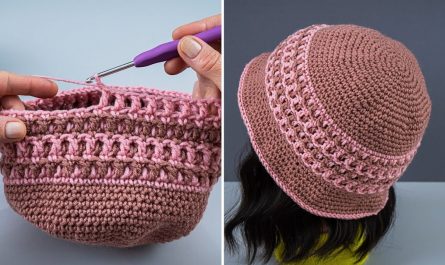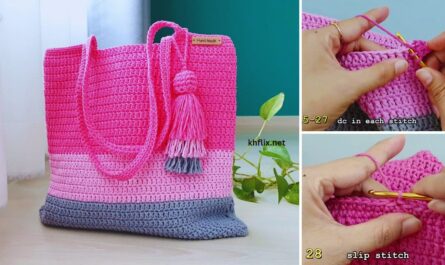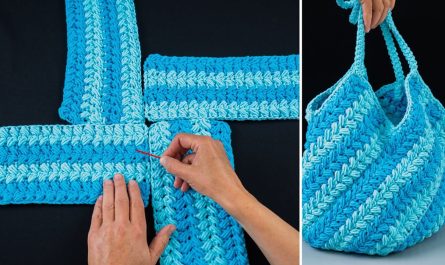Let’s create a beautiful and practical pink crochet tote bag! A single, vibrant color like pink will allow the texture of your stitches to really shine, making for an elegant and eye-catching accessory. This detailed guide will walk you through every step, from the base to the handles, ensuring a sturdy and stylish finished product.
How to Crochet a Beautiful Pink Tote Bag: A Detailed Tutorial
This comprehensive tutorial is designed to guide you through creating a sturdy and aesthetically pleasing tote bag in your chosen shade of pink. We’ll focus on construction techniques that provide durability and a clean, polished look.
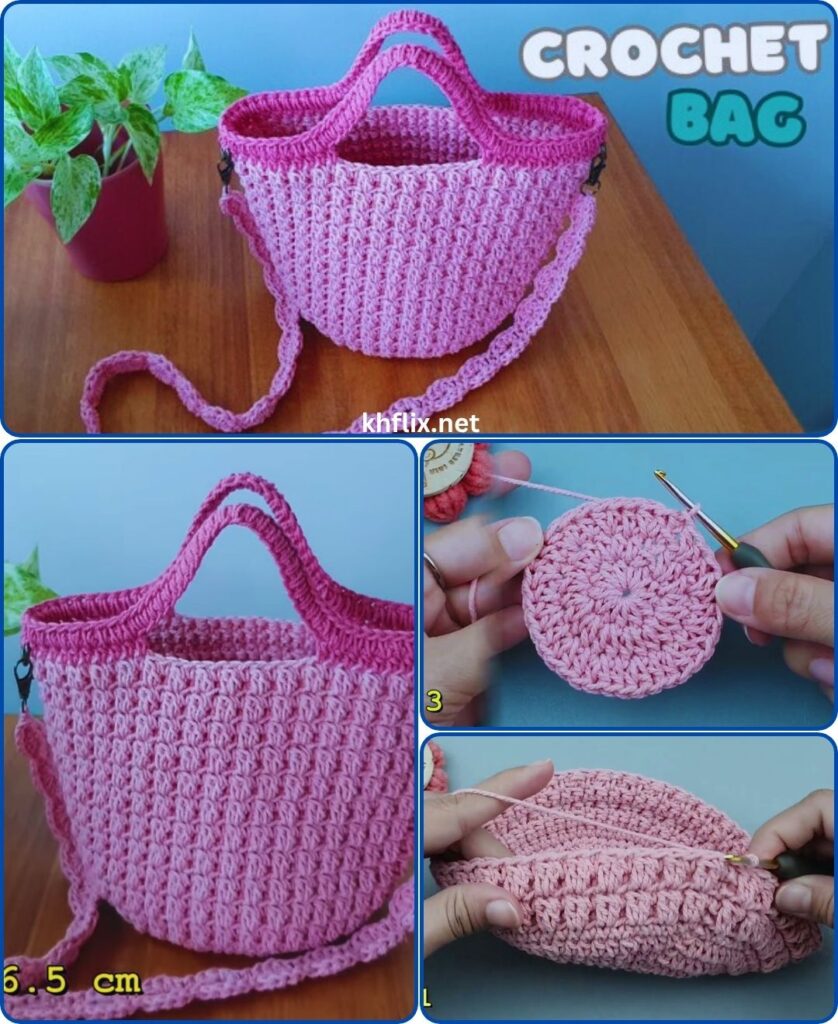
Skill Level: Intermediate
This project assumes you’re comfortable with:
- Chain (ch): The foundation of most crochet.
- Slip Stitch (sl st): For joining rounds and neatening.
- Single Crochet (sc): A dense, sturdy stitch perfect for bag bases and structure.
- Half Double Crochet (hdc): A slightly taller stitch that builds fabric quickly while maintaining good density.
- Double Crochet (dc): A taller stitch, good for some variations or specific effects.
- Working in rounds: Crocheting in a continuous or joined circular manner.
- Increasing: Adding stitches to expand your work (for the base).
- Working into specific loops (BLO/FLO): A simple technique for creating defined edges.
- Weaving in ends securely.
- Basic hand sewing (for lining and attaching handles, if applicable).
Finished Bag Dimensions (Approximate):
This pattern creates a versatile, medium-sized tote bag, typically around 12-14 inches (30-35 cm) wide and 10-12 inches (25-30 cm) tall (excluding handles). You can easily adjust the size by modifying your starting chain and the number of rounds.
Materials You’ll Need:
- Yarn: Approximately 400-500 yards (365-457 meters) of Worsted Weight (Medium #4) Cotton or Cotton Blend Yarn in your preferred shade of Pink.
- Why Cotton? Cotton yarn is the top choice for bags due to its exceptional durability, minimal stretch (which helps the bag maintain its shape), and excellent stitch definition. It can withstand daily use much better than softer yarns like acrylic.
- Pink Power: Choose any pink that speaks to you! From a soft blush to a bold fuchsia, or a sweet bubblegum pink, the single color will highlight the texture of your stitches.
- Crochet Hook: Size H/5.0mm or I/5.5mm. A 5.0mm hook generally creates a denser fabric, which is ideal for a bag that needs to hold its shape. If your tension is very tight, you might prefer a 5.5mm to prevent the fabric from being too stiff.
- Yarn Needle (Tapestry Needle): Essential for seamlessly weaving in all your loose yarn tails for a polished look.
- Scissors: For cutting your yarn.
- Stitch Markers (Optional but Highly Recommended): These are incredibly helpful for marking the beginning of your rounds, which is especially useful when working in continuous spirals.
- Bag Handles (Optional): You can crochet your own handles (instructions provided) or purchase pre-made handles (like leather, bamboo, or sturdy metal rings) for a professional touch.
- Fabric for Lining (Optional but Highly Recommended): A piece of cotton or poly-cotton fabric in a matching or complementary color, along with matching thread and a sewing machine or hand-sewing needle. A lining adds significant structure, prevents stretching, and ensures small items don’t slip through any stitch gaps.
Understanding the Bag Construction:
We’ll build this tote bag in a seamless, continuous manner for maximum durability and a clean finish. The process involves three main stages:
- Creating an Oval Base: This foundation gives your bag stability and shape.
- Building the Body: Working upwards in rounds to form the main structure of the bag.
- Adding Handles: Integrating sturdy handles for carrying.
Let’s Crochet Your Pink Tote Bag!
Part 1: Crocheting the Oval Base
A solid, flat base is crucial for your tote bag to sit upright and hold its contents without sagging. We’ll use single crochet (sc) for a dense and sturdy foundation.
- Starting Chain:
- Make a slip knot and place it on your hook.
- Chain (ch) 31. (This chain forms the initial length of your bag’s base. If you want a wider bag, chain more stitches; for a narrower one, chain fewer. Keep the number odd, as this typically results in an even number of stitches in your first working round.)
- Round 1:
- Work 2 single crochet (sc) stitches into the 2nd chain from your hook.
- Work 1 sc into each of the next 28 chains across.
- Work 3 sc into the very last chain. (This forms the smooth, curved end of your oval, turning your work around the corner.)
- Now, working down the opposite side of the foundation chain (into the bottom loops of the chains you just worked into): Work 1 sc into each of the next 28 chains across.
- Work 1 sc into the very first chain (the same chain where you placed the initial 2 sc).
- Slip stitch (sl st) into the first sc of the round to join.
- [Total: 62 sc] (This completes your first oval base round.)
- Round 2:
- Ch 1 (this chain does NOT count as a stitch, it just gives height).
- Work 2 sc into the first stitch (this is your first increase on the curve).
- Work 1 sc into the next 29 stitches.
- Work 2 sc into each of the next 3 stitches (these are increases evenly spaced around the curve).
- Work 1 sc into the next 29 stitches.
- Work 2 sc into each of the last 2 stitches (increases around the final curve to complete the oval shape).
- Sl st into the first sc to join.
- [Total: 68 sc]
- Round 3:
- Ch 1.
- Work 2 sc into the first stitch.
- Work 1 sc into the next 30 stitches.
- Work 2 sc into each of the next 3 stitches.
- Work 1 sc into the next 30 stitches.
- Work 2 sc into each of the last 2 stitches.
- Sl st into the first sc to join.
- [Total: 74 sc]
- Round 4 (Optional for a larger base):
- Ch 1.
- Work 2 sc into the first stitch.
- Work 1 sc into the next 31 stitches.
- Work 2 sc into each of the next 3 stitches.
- Work 1 sc into the next 31 stitches.
- Work 2 sc into each of the last 2 stitches.
- Sl st into the first sc to join.
- [Total: 80 sc]
- Important Base Check: At this point, your base should be a flat oval that lies nicely without curling up or ruffling excessively. If it curls, you might need to add one more round of increases following the established pattern. If it ruffles, you’ve likely increased too much in a previous round, and you may need to undo that round and adjust. The goal is a perfectly flat, stable foundation for your bag.
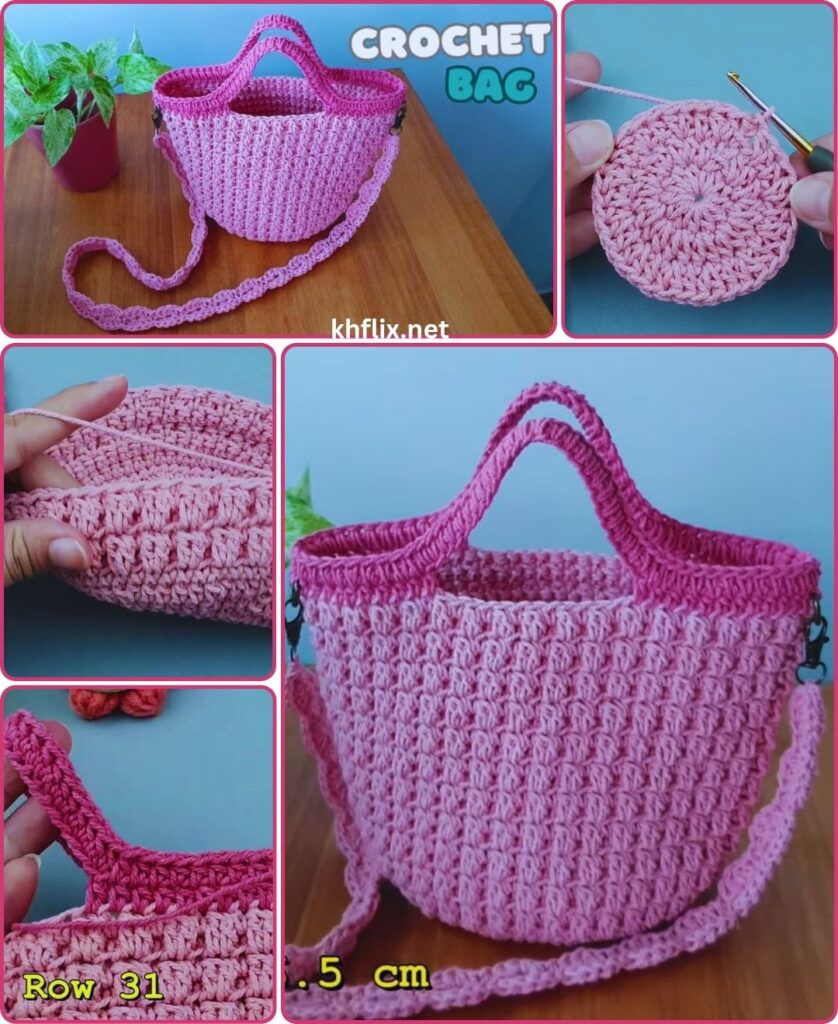
Part 2: Crocheting the Bag Body
Now we’ll transition from the flat base to build the upright sides of your tote bag. We’ll use half double crochet (hdc) for this section. Hdc creates a fabric that’s dense and sturdy, similar to single crochet, but it works up a bit faster, allowing your bag to grow efficiently.
- Round 5 (Transition to Body – Creating the Defined Edge):
- Ch 1 (does NOT count as a stitch).
- Work 1 hdc in the back loop only (BLO) of each stitch around. (This is a crucial step for a neat finish! By working only into the back loop, you create a beautiful, defined ridge where the base seamlessly transitions into the bag’s upright sides. It gives your bag a professional, structured look.)
- Sl st into the first hdc to join.
- [Total: 80 hdc] (Your stitch count will remain exactly the same as your final base round, but the fabric will now start to turn upwards.)
- Round 6 onwards (Building the Bag Sides):
- Ch 1 (does NOT count as a stitch).
- Work 1 hdc into each stitch around (now working through both loops as you normally would for hdc).
- Sl st into the first hdc to join.
- [Total: 80 hdc]
- Repeat this Round (Round 6) until your bag reaches the desired height. For a medium tote, aim for approximately 15-20 additional rounds of hdc, which should result in a bag about 8-10 inches (20-25 cm) tall from the base ridge. Adjust the number of rounds to make your bag taller or shorter as you prefer.
Part 3: Finishing the Top Edge
A neat and sturdy top edge is essential for the bag’s overall structure and provides a firm foundation for attaching your handles. We’ll finish with a few rounds of single crochet (sc) for extra firmness.
- Final Rounds for Top Edge:
- After completing your final hdc body round, Ch 1 (does NOT count as a stitch).
- Work 1 sc in each stitch around.
- Sl st into the first sc to join.
- [Total: 80 sc]
- Repeat this sc round for 2-3 more times. This creates a very tight, dense, and firm top border. This firmness is key to preventing the top of your bag from stretching out over time and provides a solid base for securely attaching your handles.
- Fasten off, leaving a 6-inch (15 cm) tail of yarn for weaving in later.
Part 4: Creating and Attaching Handles
You have flexibility here! You can crochet your own handles for a fully handmade look, or attach pre-made ones for a more commercial finish.
Option A: Crocheted Handles (Recommended for beginners)
- Crocheting the Handles (Make 2):
- With your pink yarn, Ch 8. (This will be the width of your handle. If you want a wider handle, chain more stitches; for a narrower one, chain fewer.)
- Work 1 sc into the 2nd chain from your hook and in each chain across. (You should now have 7 sc).
- Ch 1, turn (this is your turning chain for the next row).
- Work 1 sc into each of the 7 sc across.
- Repeat the last step (Ch 1, turn, sc across) until your strap reaches the desired length. For a typical shoulder tote, aim for approximately 18-24 inches (45-60 cm). For shorter hand straps, 10-12 inches (25-30 cm) is usually sufficient.
- Fasten off, leaving a very long tail (at least 12-18 inches / 30-45 cm) on each end of the handle for sewing.
- Attaching the Handles:
- Lay your completed bag flat and gently flatten it out so the side “creases” are even. This helps ensure your handles are symmetrically placed.
- Position your first handle. On one side of the bag, measure in approximately 3-4 inches (7.5-10 cm) from each flattened side crease along the top edge. These points mark where you’ll attach the handle. You can use stitch markers to temporarily mark these spots.
- Thread one of the long tails of the handle onto your yarn needle.
- Align one end of the handle with one of your marked spots on the inside of the bag’s top border.
- Using your yarn needle, firmly sew the handle end to the bag’s top border. Pass your needle through multiple layers of the bag’s sturdy sc stitches. Make several passes and criss-cross stitches to ensure the handle is incredibly secure and can withstand weight.
- Repeat for the other end of the first handle, attaching it to the second marked spot on the same side of the bag.
- Repeat the entire process for the second handle on the opposite side of the bag, taking care to ensure it is positioned symmetrically to the first.
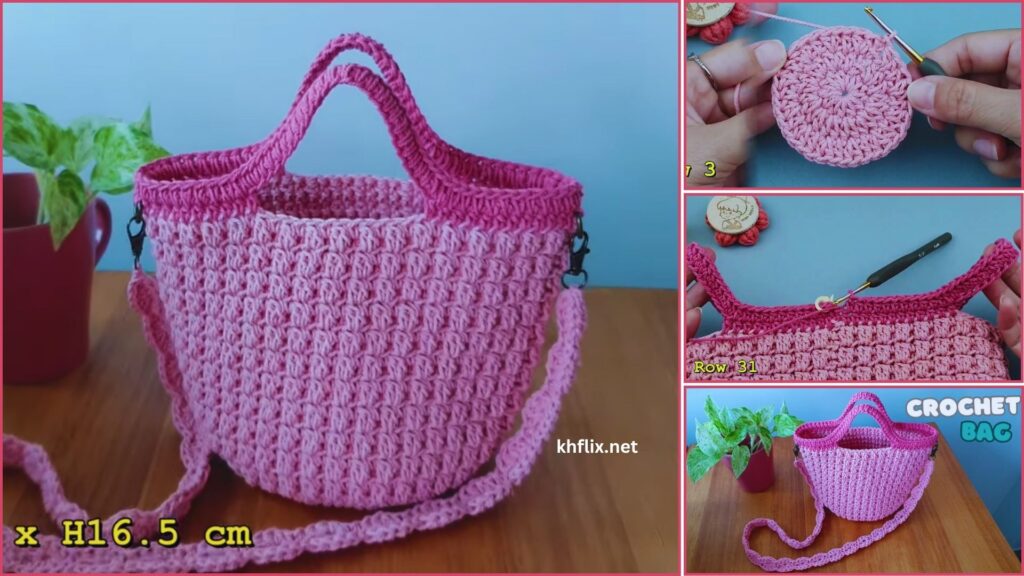
Option B: Purchased Handles
If you opt for pre-made handles (like leather, bamboo, or metal rings), they can give your bag a very polished, high-end look.
- Follow the specific instructions that come with your purchased handles. Most will have small holes for sewing or integrated clips.
- Attach: Position them evenly on the top edge of your bag, mirroring the placement for crocheted handles. Use strong sewing thread (matching your yarn or a clear nylon/polyester thread) and a regular sewing needle to firmly stitch them to the top sc border of the crochet fabric. Stitch through multiple times for maximum security.
Part 5: Finishing Touches (Highly Recommended for a Truly “Beautiful” Bag!)
These final steps are what will truly make your handmade bag look polished, professional, and built to last. Don’t skip them!
- Weave in ALL Ends: This is often the least favorite part of crocheting, but it’s absolutely critical for a clean, neat, and durable bag. Use your yarn needle to meticulously weave in all remaining tails (from your starting chain, any Fasten Off points, and handle sewing tails).
- How to Weave Neatly: Weave the tails into the stitches on the inside of the bag. The trick is to weave them into stitches of the same color. Weave in one direction for about 1.5-2 inches (4-5 cm), then subtly change direction and weave back through some of the same stitches. This “locks” the tail in place and prevents it from unraveling. Be patient and thorough; well-woven ends are practically invisible and significantly contribute to your bag’s longevity and appearance.
- Blocking (Optional but Very Helpful): Blocking is a process that sets your stitches, evens out tension, and helps your bag take on its intended shape. It can make a huge difference in the final look.
- Gently stuff your bag with towels, old t-shirts, or crumpled paper to fill it to its desired shape. Ensure it’s plump and even.
- Using a spray bottle, lightly mist the entire bag evenly with water (if using cotton yarn). For some synthetic fibers, you can gently hover a steamer or an iron (on a low, steam setting) over the fabric without touching it.
- Gently shape the bag with your hands while it’s damp, ensuring the base is flat, the sides are even, and the handles are positioned correctly.
- Allow the bag to air dry completely and thoroughly before removing the stuffing. This can take 24-48 hours.
- Lining the Bag (Highly Recommended for Durability & Functionality): A fabric lining is a game-changer for crochet bags. It provides significant structure, prevents the bag from stretching out, helps it hold its shape even when filled, and, crucially, ensures small items (like keys, pens, or coins) don’t slip through any tiny gaps in your crochet stitches.
- Measure: Carefully measure the finished dimensions of your crochet bag: its height, its width, and the length/width of its oval base.
- Cut Fabric: Cut fabric pieces to match the inside dimensions of your bag. You’ll typically need a main body piece (a large rectangle that will wrap around the inside) and a separate oval piece for the bottom, mirroring your crocheted base. Remember to add a generous seam allowance (e.g., 1/2 inch or 1.2 cm) to all edges of your fabric pieces.
- Sew Fabric Lining: Stitch the fabric pieces together (right sides facing each other) to create a fabric “bag” that will fit snugly inside your crochet bag. Press all seams open for a neat finish. Create a neat hem around the top edge of the fabric lining.
- Insert and Secure: Carefully place the completed fabric lining inside your crochet bag. Align the top edges of both the crochet bag and the lining. Fold the hemmed top edge of the lining over the top edge of the crochet bag slightly (if needed) to create a clean finish. Then, using matching thread and a hand-sewing needle, hand-stitch the lining securely to the inside top edge of the crochet bag. Stitch carefully so the stitches are not visible from the outside of your beautiful bag.
- Closure (Optional): If you want to add a closure to your bag, consider a magnetic snap (sewn between the lining and crochet fabric at the top center), a simple button and loop, or even a zipper if you’re feeling ambitious (which would typically be sewn into the lining).
Congratulations! You’ve now created a truly beautiful, sturdy, and functional pink crochet tote bag that’s ready to carry your essentials in style. This handmade accessory is a wonderful testament to your dedication and creativity! What will you fill your new tote with first?


